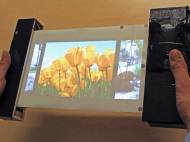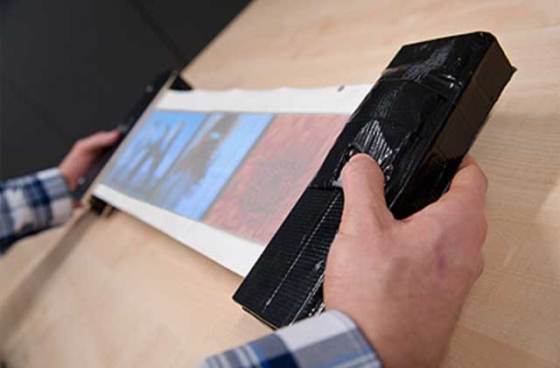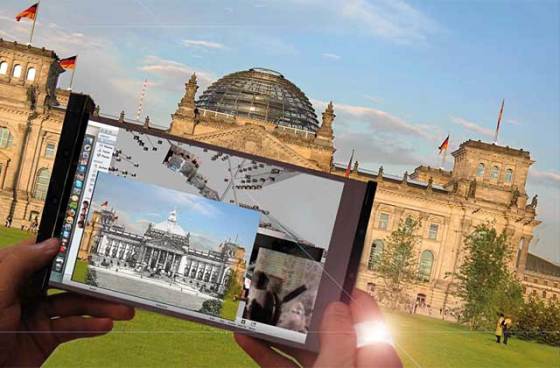A roadmap for the mobile phones of the future and rollable displays
 Technische Universität Darmstadt’s “Future Internet” research group recently published a set of challenges needed to tackle in order to incorporate their vision of what mobile telephony may look like in next ten to fifteen years. They envision that the mobile telephones of the future will be able to see, shrink in size while getting larger displays, and slip into their user’s skins.
Technische Universität Darmstadt’s “Future Internet” research group recently published a set of challenges needed to tackle in order to incorporate their vision of what mobile telephony may look like in next ten to fifteen years. They envision that the mobile telephones of the future will be able to see, shrink in size while getting larger displays, and slip into their user’s skins.
Professor Dr. Max Mühlhäuser, head of the roadmap project, commented that members of the Darmstadt team are already proposing solutions to issues that need addressing. When it comes to hardware, this team envisions mobile telephones that have large displays and are able to be folded to the size of a pencil. The team envisions that an advanced version of the Xpaaand prototype they presented a couple of years ago could serve as a platform.
Xpaand prototype and interaction techniques for rollable displays
Xpaaand is a prototypical realization of a handheld device in which the screen real estate can be dynamically adjusted and it can rolled in and out in a way very similar to ancient paper scrolls. Two handles on two opposing sides of the display provide for holding the device in a comfortable manner, either in landscape or in portrait mode, with one or two hands. The device, and hence the display, can be physically expanded in one dimension by pulling both handles apart. It can be collapsed by pushing them together. Once the device is resized it maintains its new size.
Despite the advances in development of flexible displays, the researchers chose a passive display approach and developed a prototype that emulates the most important properties of the envisioned device – the rollable display and physical resizing.
The system tracks the physical position of the Xpaaand prototype with a 6-camera OptiTrack system using IR retro-reflective markers, and a Full-HD overhead projector is used to display digital content on the device. This allows projection of the image that would be displayed by a real flexible display while the prototype is moved naturally.
The Xpaaand prototype consists of a physical scroll made of white foil, where display content is projected. It can be resized to widths from 5 to 39 cm (2 to 15.35 inches) at a fix height of 18 cm (7 inches). It is 4cm (1.57 inches) thick and weights about 900g (2 pounds). A box is attached at each of the two ends. These boxes act as physical handles for easily grasping the device; they contain the scroll and electronic components.
By embedding accelerometers in both handles, the device can sense which side is actuated. Xpaaand can distinguish three types of resizing: pulling-out or pushing-in the left side of the display, the right side, or both sides (symmetric). These three types can be mapped to different functionality of the information interaction and displaying. You can see the examples in the following video.
A physical button is positioned at the center of each of the boxes. That version of the prototype doesn’t support touch input and to support navigation on the display while it is held with two hands, a trackball is integrated into one box. It can be manipulated with the dominant hand (left-handers can rotate the device by 180 degrees).
While there are hurdles to overcome in development of the hardware, and it might be more suitable for future tablets or high end digital cameras rather than mobile phones, a variation of such platform could prove to be the wining combination for realization of future handheld devices.
Other goals set by Darmstadt researchers
The displays of future mobile telephones will merge virtual and physical reality. While there are many examples of augmented reality we previously wrote about, this is one of the most probable predictions once communities decide to use a universal platform where users contribute data. TU Darmstadt researchers mentioned an example where the camera of a mobile device is pointed at Berlin’s Reichtag, and the device can overlay its image with a 3D view of that building, as it appeared back in the 1920s.
Future mobile-telephone networks will have to be capable of handling much higher transmission rates than their current counterparts. Mobile telephones and their networks will have to be more flexible in dealing with variations in signal levels. Mobile telephones will have to return responses from the “cloud” on a millisecond time scale, where a portion of the “cloud” will have to shift to mobile-telephone users’ immediate vicinities. Mühlhäuser calls those mobile portions of the “cloud” “cloudlets.”
The Darmstadt roadmap also envisions how future mobile telephones will become the heart of new security concepts. Since mobile telephones are handling growing numbers of critical smart-phone services, such as opening doors or handling payment of tolls, legal and financial risks will be involved. They envision an encapsulated nanocomputer that is not under the thumb of commercial interests that can become users’ “second skin”. Such tiny delegates to the virtual world could be incorporated into, e.g., users’ finger rings, and would manage their passwords and payment accounts or control exchanges of their personal data with the environment.











Leave your response!